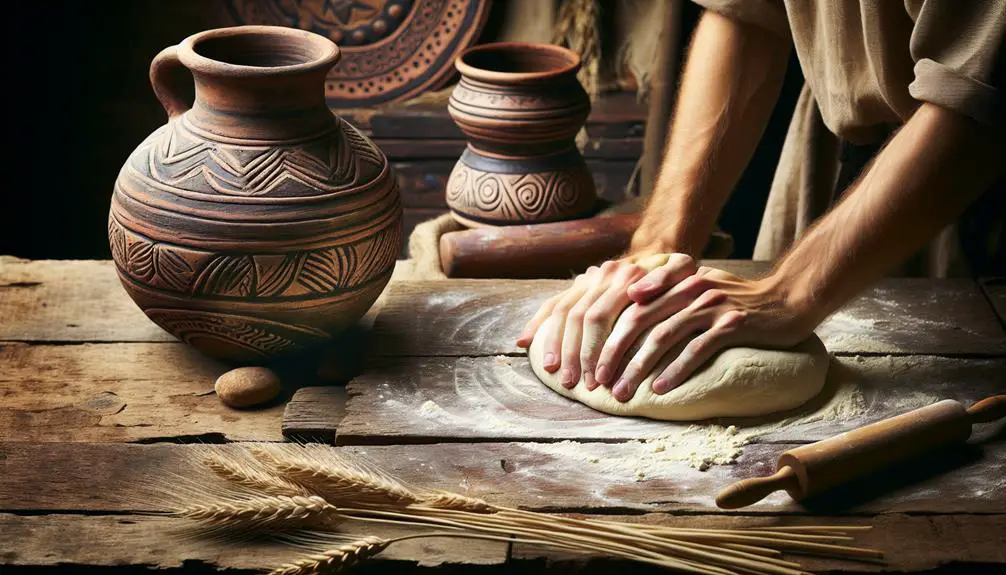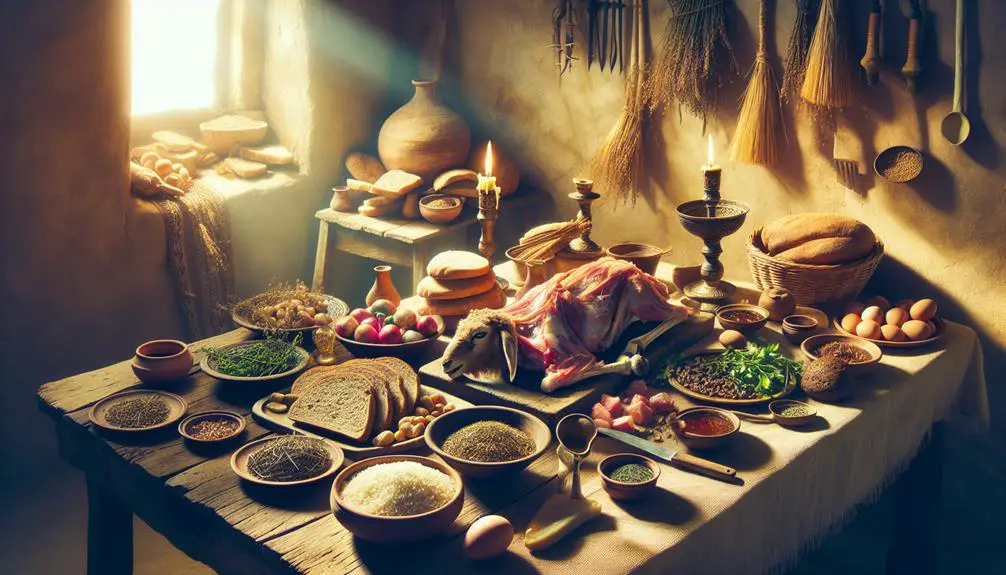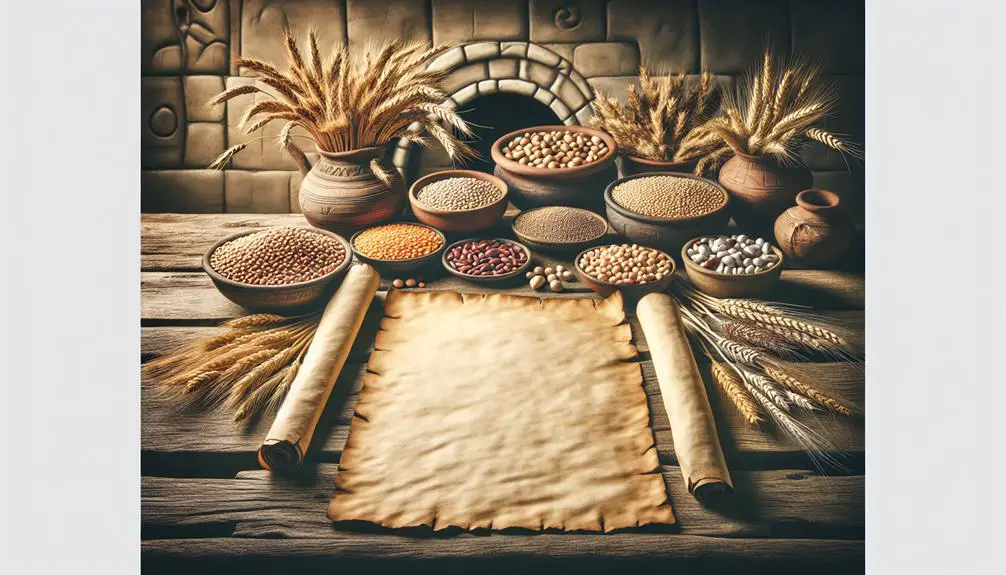Discover ancient culinary secrets and spiritual insights through the intriguing recipes found in the Bible.

Recipes in the Bible
The Bible, revered for its spiritual guidance and historical significance, also serves as an intriguing repository of ancient culinary practices. From unleavened bread to the Passover lamb, these biblical recipes offer a unique window into the dietary habits and cultural rituals of ancient societies.
While some dishes, like manna from heaven or Ezekiel's bread, carry profound symbolic meanings, others, such as the lentil stew Esau traded his birthright for, reveal the everyday life and values of ancient peoples.
Exploring these recipes not only enriches our understanding of biblical narratives but also invites us to ponder the role of food in our own cultural and spiritual lives. What insights can these age-old recipes provide into modern culinary practices and spiritual reflections?
Key Takeaways
- Biblical recipes symbolize spiritual sustenance and connection, like manna representing reliance on divine provision.
- Ingredients and preparation in biblical recipes reflect deep symbolic meanings, such as the Passover lamb symbolizing liberation and divine protection.
- These recipes highlight the integral role of food in religious practices and cultural identity, connecting past traditions with present beliefs.
- Biblical recipes, including Ezekiel's Bread and the fishes and loaves miracle, demonstrate the adaptation of ancient dietary laws to modern health consciousness.
Unleavened Bread Tradition

The tradition of unleavened bread, deeply rooted in biblical narratives, symbolizes purity and the swift exodus of the Israelites from Egypt, reflecting a profound aspect of religious observance and historical remembrance. This emblematic food item, devoid of leavening agents, underscores a narrative of urgency and divine command, encapsulating a ritualistic memory that has been preserved across millennia. In contemporary religious practices, unleavened bread maintains its ceremonial significance, serving as a tangible link to ancestral faith and collective identity.
The evolution of this tradition, however, has not remained static. Modern adaptations and ingredient substitutions have emerged, reflecting both changing dietary needs and the globalization of food culture. Scholars and practitioners alike have observed these adaptations as a means to both preserve and contemporize ancient religious rites. For instance, the incorporation of gluten-free flours caters to the health requirements of the modern-day faithful, ensuring that the tradition remains inclusive and accessible to all. Similarly, variations in flavoring and composition, while maintaining the absence of leaven, demonstrate a balance between adherence to scriptural mandates and the culinary diversity of the global Jewish diaspora.
These adaptations, however, are not merely pragmatic. They also serve as a testament to the dynamic nature of religious tradition, illustrating how ancient practices can be both preserved in their essence and made relevant to contemporary life. Through the lens of unleavened bread, one can discern the intricate ways in which religious observance adapts to the changing landscapes of culture, health, and community, while steadfastly maintaining its core symbolic meanings.
The Passover Lamb

Transitioning from the unleavened bread tradition, the Passover Lamb emerges as a pivotal element within biblical narratives. It embodies deep historical significance, intricate preparation rituals, and profound symbolic meanings.
The examination of these facets offers insights into the cultural, religious, and societal underpinnings of ancient practices. This analysis not only enriches our understanding of biblical texts but also illuminates the enduring legacy of these rituals in contemporary religious observances.
Historical Significance
In examining the historical significance of the Passover lamb, it is essential to recognize its profound impact on cultural and religious practices throughout history. This emblematic ritual, deeply rooted in the Judeo-Christian traditions, symbolizes liberation and divine protection. Its observance has led to various cultural adaptations, reflecting the evolving interpretation and adherence to ancient dietary laws.
These laws, integral to the ritual, have not only shaped religious observance but also influenced social and familial customs. The Passover lamb serves as a testament to the enduring nature of religious rites, illustrating how they adapt while retaining their core significance. It highlights the intricate relationship between faith, food, and identity, demonstrating how dietary practices are imbued with historical and spiritual meanings.
Preparation Rituals
Delving into the preparation rituals of the Passover lamb reveals a meticulous process that embodies both reverence and tradition, deeply rooted in religious texts and practices. This process begins with stringent ingredient sourcing, ensuring the lamb meets specific criteria outlined in religious doctrines, emphasizing purity and age.
The cooking methods prescribed are equally precise, with instructions that not only ensure the lamb is prepared in a manner that retains its symbolic significance but also adheres to ancient culinary techniques. These methods include roasting over an open fire, a technique that dates back millennia and reflects the historical context in which these rituals were established.
Each step, from sourcing to cooking, is imbued with symbolic meaning, underscoring the ritual's importance in connecting past and present through shared culinary heritage.
Symbolic Meanings
The Passover lamb holds profound symbolic significance, serving as a cornerstone in the narrative of liberation and divine intervention within religious traditions. This embodiment of sacrifice and redemption is intricately woven with other elements of symbolic import, such as fruit symbolism and olive oil, each contributing layers of meaning to the rituals and narratives.
- Fruit symbolism often represents abundance, fertility, and the sweetness of life, juxtaposing the bitter herbs of Passover to signify the complexity of existence.
- Olive oil, a symbol of anointing and purity, enriches the ritualistic practices, highlighting the sanctity and consecration inherent in these observances.
- The Passover lamb itself symbolizes deliverance and covenant, marking a pivotal moment of transition from slavery to freedom.
These symbols together enrich the tapestry of spiritual and cultural heritage, offering deep insights into the values and beliefs of the communities that hold these traditions dear.
Manna From Heaven

The biblical account of Manna from Heaven presents a unique intersection of divine providence, dietary sustenance, and ritual practice among the Israelites during their exodus. This miraculous food not only underscores the direct intervention of the divine in human affairs but also offers insights into the everyday life and spiritual obedience of the ancient Israelites through its gathering and preparation methods.
An analysis of Manna's divine origin, as well as the prescribed methods for its collection and culinary treatment, reveals the complex interplay between faith, community, and sustenance in the biblical narrative.
Manna's Divine Origin
Manna, often described as bread from heaven, represents a miraculous food source provided by divine intervention according to biblical narratives. This divine provision not only sustained the Israelites but has intrigued scholars and theologians regarding its origins and implications.
- Nutritional Analysis: The exploration of manna's composition raises questions about how a single food source could sustain a population, pointing towards a miraculous sustenance.
- Ecological Impact: The appearance of manna, without natural precedent, suggests a supernatural ecological intervention, with no harm to the existing environment.
- Divine Intervention: The delivery of manna underscores a direct act of provision by a higher power, emphasizing the relationship between the divine and the sustenance of the faithful.
Analyzing manna from these perspectives underscores its significance beyond a mere historical or nutritional curiosity, highlighting its role as a symbol of divine care and provision.
Gathering and Preparation
Upon examining the biblical accounts, the process of gathering and preparing manna emerges as a distinctive practice, intricately tied to the beliefs and daily lives of the Israelites. Ingredient sourcing for manna was unique, as it was described as bread from heaven, requiring no traditional agricultural efforts but rather an adherence to divine instructions for daily collection, emphasizing reliance on spiritual sustenance.
Cooking techniques were simple yet deeply symbolic, involving grinding, beating, boiling, and baking, reflecting a form of preparation that transcended mere culinary activity to represent subsistence provided by divine grace. This methodological approach to gathering and preparation not only ensured physical nourishment but also reinforced spiritual obedience and trust in divine provision, encapsulating a holistic form of sustenance.
Ezekiel's Bread

Amidst the diverse culinary references found within the scriptural texts, Ezekiel's Bread stands out as a multifaceted symbol, embodying both the austerity of ancient diets and the theological richness of biblical teachings. This bread, detailed in the Book of Ezekiel, is not merely a recipe but a directive from God to the prophet Ezekiel, serving as a tangible representation of the Israelites' forthcoming exile and survival. The composition of Ezekiel's Bread, which combines various grains and legumes, is reflective of a diet meant to sustain an individual through periods of scarcity and hardship.
The recipe for Ezekiel's Bread, as prescribed in the scriptures, has found resonance in modern nutritional discussions, primarily due to its:
- Health benefits, including a high fiber content, a complete protein profile due to the combination of grains and legumes, and an abundance of essential nutrients.
- Modern adaptations of the recipe, which often incorporate contemporary baking techniques and ingredients to cater to current dietary preferences and restrictions.
- The bread's symbolic significance, which continues to inspire a spiritual connection to sustenance and mindfulness in eating practices.
Analyzing Ezekiel's Bread from both a historical and nutritional perspective reveals its enduring relevance. The bread's composition is emblematic of an ancient diet that prioritizes wholesomeness and sustainability, principles that are increasingly valued in today's health-conscious society. Furthermore, the modern adaptations of Ezekiel's Bread not only make it accessible to a wider audience but also underscore the adaptability of biblical teachings to contemporary life, enriching the spiritual and physical well-being of individuals across generations.
Fishes and Loaves Miracle

One of the most emblematic narratives of sustenance in the Bible is the miracle of the fishes and loaves, which not only showcases a profound moment of divine provision but also reflects the cultural and theological significance of food in biblical times. This event, chronicled in multiple gospels, illustrates Jesus feeding multitudes with seemingly insufficient resources: five loaves of bread and two fish. The miracle's significance transcends the mere act of feeding; it symbolizes God's endless bounty and his care for the physical needs of his followers.
Analyzing the cultural context, bread and fish were staple foods in the ancient Near East, accessible to the common people. Thus, the miracle resonates with the audience's everyday experiences, emphasizing that the divine interacts with the mundane to fulfill both spiritual and corporeal needs. The act of breaking bread, moreover, carries deep communal and ritual connotations, reinforcing the message of fellowship and shared sustenance.
Theologically, the fishes and loaves miracle prefigures the Eucharist, embodying the idea of spiritual nourishment and the sharing of Christ himself. It underscores a pivotal theme in Christian doctrine: Jesus as the Bread of Life, offering himself as sustenance for the world's salvation. Moreover, the miraculous multiplication hints at the Kingdom of God's abundant nature, where material limits are transcended by divine grace.
Bitter Herbs of Passover

Moving from the Christian narrative of the fishes and loaves, the exploration of food in biblical contexts brings us to the Jewish tradition of Passover, specifically the symbolic use of bitter herbs. These herbs, known in Hebrew as 'Maror,' are a crucial component of the Passover Seder, embodying the bitterness of slavery endured by the Israelites in Egypt. The consumption of bitter herbs during this ritual meal serves as a poignant reminder of the hardships of the past, while also celebrating the subsequent liberation.
The significance of bitter herbs transcends historical and religious symbolism; it extends into the realm of health and dietary practices. Modern adaptations of the Passover tradition have seen a broader interpretation of what constitutes 'bitter herbs,' integrating a variety of greens that offer not just symbolic meaning but also tangible health benefits. These include:
- Horseradish: Traditionally used as Maror, horseradish is rich in antioxidants and compounds that may aid in digestion and respiratory health.
- Endive and Romaine Lettuce: Less intense but equally symbolic, these greens are high in fiber, vitamins, and minerals.
- Parsley: Often used in the Seder plate, parsley is packed with vitamins A, C, and K, and has been linked to bone health and immune system support.
In the context of modern observance, these bitter herbs are not only a nod to the past but also align with contemporary understandings of nutrition and well-being. This integration of ancient tradition with modern health consciousness exemplifies how traditional practices can adapt and thrive in today's world, offering layers of meaning that are both historical and immediately relevant.
Abraham's Calf and Curds

Delving into the narrative of Genesis 18, we encounter the hospitality of Abraham towards his divine visitors, marked by the preparation of a calf and curds, which underscores the significance of food hospitality and dietary customs in ancient biblical times. This account not only reveals Abraham's generosity and respect towards his guests but also provides insights into the culinary techniques and dietary customs that were prevalent in the Near East during this era.
Abraham's choice of dishes—calf and curds—reflects a diet rich in dairy and meat, staples within nomadic and pastoral societies of the ancient Near East. The preparation of the calf, likely involving roasting, signifies a special occasion, given the effort and resources required for such a meal. This aligns with the societal norms where meat was not an everyday fare but reserved for significant events or distinguished guests.
The inclusion of curds alongside the calf points towards an integrated dietary habit of combining animal proteins with dairy products, a practice that echoes across various ancient cultures. The curds, essentially a form of yogurt or soft cheese, would have been a product of the domestication of animals and the development of dairy processing techniques. This detail not only highlights the culinary sophistication of the time but also the dietary customs that appreciated the nutritional value of combining different food groups.
Analyzing this biblical meal through the lens of culinary techniques and dietary customs offers a richer understanding of the social and cultural contexts of ancient biblical times. It illustrates how food was not merely sustenance but a medium of hospitality, respect, and social bonding, reflecting the intertwined nature of food, culture, and religion in human history.
Lentil Stew for Esau

In the Book of Genesis, the narrative surrounding Esau's exchange of his birthright for a bowl of lentil stew offers a profound exploration into the societal and cultural implications of food in biblical times. This story not only highlights Esau's impatience and immediate gratification over long-term blessings but also underscores Jacob's cunning in leveraging a moment of weakness to his advantage. The lentil stew, seemingly mundane, becomes a pivotal element in the unfolding of the biblical patriarchal lineage, suggesting a complex interplay of immediate needs versus future inheritance.
Several key aspects emerge from this account:
- The Role of Food in Cultural and Familial Transactions: The exchange showcases how food, a basic necessity, can be elevated to a tool of negotiation and a symbol of larger transactions within a family and society.
- Character Flaws and Virtues: Esau's impatience and Jacob's cunning are not merely personal traits but are illustrative of broader themes of human nature and morality within the biblical narrative.
- Spiritual and Secular Values: The story juxtaposes the immediate satisfaction derived from physical sustenance against the long-term spiritual and material benefits symbolized by the birthright.
This narrative invites a closer examination of the biblical view on sustenance, inheritance, and the consequences of one's choices. It also reflects on the societal norms of the time, where food could serve as currency in pivotal life-changing decisions. The lentil stew for Esau is more than a meal; it is a catalyst that sets in motion a series of events redefining the future of the biblical patriarchs.
Frequently Asked Questions
How Do Modern Dietary Laws or Restrictions (Such as Veganism or Gluten Intolerance) Affect the Preparation and Consumption of These Biblical Recipes Today?
Modern dietary laws or restrictions significantly influence the preparation and consumption of traditional recipes. Ingredient substitutions and modifications in cooking methods are essential to align these dishes with contemporary dietary practices, such as veganism or gluten intolerance. Analyzing these adaptations provides insight into the evolving nature of culinary traditions, underscoring the dynamic interplay between historical dietary guidelines and current nutritional understanding.
This analysis reveals the adaptability of traditional recipes to meet modern health and ethical considerations.
Are There Any Documented Historical Changes or Evolutions in the Preparation of These Biblical Recipes Over the Centuries?
The evolution of culinary practices over centuries has been influenced by factors such as the availability of ancient cookware and seasonal variations in ingredient availability. Historical documents and archaeological findings suggest that these changes have significantly impacted the preparation methods of traditional dishes.
Analyzing these transformations provides insights into how societies adapted their cooking techniques to accommodate technological advancements and environmental changes, reflecting broader trends in cultural and dietary evolution.
How Do Different Christian Denominations or Jewish Sects Vary in Their Interpretation and Culinary Inclusion of These Biblical Recipes in Their Religious Practices?
Different Christian denominations and Jewish sects exhibit notable variations in the interpretation and culinary incorporation of ancient recipes into their religious practices.
These divergences are particularly evident in festival variations and interfaith interpretations, underscoring the rich tapestry of cultural and theological perspectives that influence religious dietary customs.
This analytical observation reveals the complexity of religious traditions and the dynamic ways in which ancient culinary practices are adapted and celebrated within contemporary religious contexts.
Can Any of These Biblical Recipes Be Traced to Specific Geographical Locations or Cultures Outside of the Immediate Biblical Context?
The current inquiry seeks to unravel whether culinary practices have seeped beyond their native soils, akin to seeds carried by ancient trade winds.
Through a scholarly lens, this investigation delves into the interplay between archeological evidence and historical narratives, aiming to pinpoint the diffusion of specific culinary traditions.
Ancillary to this, the exploration assesses the impact of ancient trade routes in disseminating these practices across diverse geographical landscapes and cultural boundaries.
How Do These Biblical Food Items and Recipes Compare Nutritionally to Modern Diets, and What Are Their Health Benefits or Drawbacks According to Contemporary Dietary Science?
A nutritional analysis of historical food items and recipes reveals significant insights into their health implications when compared to modern dietary standards.
Contemporary dietary science allows for a detailed examination of the nutritional content, offering a perspective on potential health benefits or drawbacks.
Such an analysis can illuminate the nutritional adequacy or deficiencies of these diets, providing a comprehensive understanding of their impact on health in a current context.
Conclusion
In conclusion, the examination of culinary traditions and recipes within the biblical text not only offers insight into the dietary practices and religious observances of ancient cultures but also contributes to a broader understanding of the socio-cultural and theological significance of food in human history.
While some may argue that interpreting these narratives as literal recipes diminishes their spiritual meaning, it is precisely this intersection of the mundane and the divine that enriches the study, revealing the profound ways in which food and faith are intertwined.



Sign up